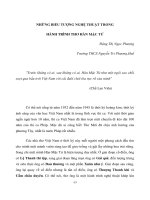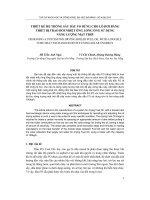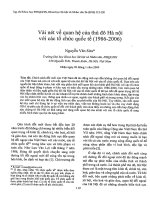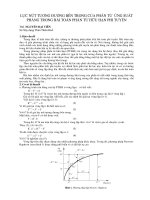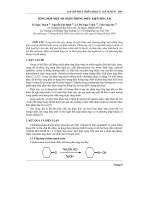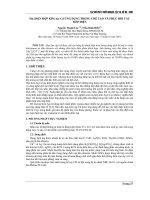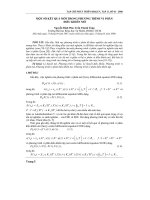Báo cáo nghiên cứu khoa học: "Tán xạ raman cưỡng bức trong gần đúng ba chiều" pps
Bạn đang xem bản rút gọn của tài liệu. Xem và tải ngay bản đầy đủ của tài liệu tại đây (129.19 KB, 6 trang )
tr−êng §¹i häc Vinh
T¹p chÝ khoa häc, tËp XXXVII, sè 2A-2008
37
RAMAN STIMULATED SCATTERING
IN THREE-DIMENSIONAL APPROACH
Chu Van Lanh
(a)
, Dinh Xuan Khoa
(a)
,
Ho Quang Quy
(b)
, Pham Thi Thuy Van
(c)
Abstract. In this paper we present a theory of Raman stimulated scattering in
three-dimensional approach. The intensity of Stokes waves is introduced and
discussed in two limit conditions, there are transient limit and steady-state limit.
I. THREE-DIMENSIONAL MAXWELL-BLOCK EQUATIONS
We consider a collection of indentical atoms or molecules initially in ground
states, contained in a pensil-shaped volume with length L and cross-sectional area
A. The atomic positions are random, but fixed, and the average number density is N
(atoms cm
-3
). A laser with electric field
)(
*
)(
),(),().,(
zkti
L
zkti
LL
LLLL
etrEetrEtr
−−−
==
ωω
ε
ρ
ρ
ρ
propagates through the volume in the z direction, which is parallel to the pencil
axis. As shown in Fig.1, an atom may absorb a laser photon at frequency
L
ω
and
scatters a photon at Stokes frequency
31
ωωω
−=
LS
, ending up in the final state
3
. We will treat the laser field mode as a classical electromagnetic wave and
assume that it does not undergo depletion or any other back reaction from the
medium. On the other hand, the remaining modes of radiation field will be treated
quantum mechanically, to allow for the spontaneous initiation of Raman scattering.
As well as shown in previous works [1, 2, 3], we introduce a set of Maxwell-
Block equations, describing Raman stimulated scattering in three-dimensional
space:
),(
ˆ
),(
ˆ
),(
ˆ
),(
ˆ
),(
ˆ
),(
ˆ
),(
ˆ
.2
).,(
ˆ
1
*
1
)(
*
*
2
)(
2
2
2
2
trFtrEtrEiktrQtrQ
t
etrQtrE
tc
k
etrE
tc
SL
zkti
L
S
zkti
S
SSSS
ρρρρρ
ρρρ
+−Γ−=
∂
∂
∂
∂
=
∂
∂
−∇
+
−−−−
+
ωω
ω
(1)
where ),(
ˆ
trE
L
ρ
is the intensity operator of laser field with slowly-varying envelope
approximation,
),(
ˆ
trE
S
ρ
+
is the intensity operator of Stokes field with slowly-varying
envelope approximation, dependent on frequency
S
ω
, ),(
ˆ
trQ
ρ
is the atomic-transition
operator, which describes the relation between two states
1
and
3
(see Fig. 1),
Q
ˆ
Γ is the term describing damping of ),(
ˆ
trQ
ρ
at a collisional dephasing rate
NhËn bµi ngµy 23/4/2008. Söa ch÷a xong 12/6/2008.
C. V. Lanh , D. X. Khoa, H. Q. Quy, P. T. T. Van RAMAN STIMULATED , Tr. 37-42
38
Γ
, ),(
ˆ
trF
ρ
is the quatum statistical Langevin operator describing the collisional-
induced fluctuations,
c
k
L
L
ω
= ,
c
k
S
S
ω
= are the wave numbers of the laser field and
Stokes field, respectively, and k
1
, k
2
are the coupling constants given by:
c
kN
k
ddk
S
SmLm
m
mm
*
1
2
11
13
2
1
.2
],
11
[
ωπ
ωωωω
η
η
=
+
+
−
=
∑
−
(2)
with c is the light velosity, and
>=< jdid
ij
/
ˆ
/
is the atomic dipole matrix element.
The atomic and Langevin operators have property:
).()(2),(
ˆ
),(
ˆ
)()'0,(
ˆ
)0,(
ˆ
31
31
rrttNtrFtrF
rrNrQrQ
′
−
′
−Γ=>
′′
<
′
−=>
′
<
−+
−+
ρρρρ
ρ
ρ
ρ
ρ
δδ
δ
(3)
Two important quantities presenting in the resolution of this set of equations
are: Raman gain coefficient
2
1
21
),(2 trEkkg
L
ρ
−
Γ=
(4)
and Fresnel number
Φ =
L
A
S
λ
(5)
with
S
λ
is the wavelength of the Stokes field.
1
3
ω
L
ω
S
m
Fig.1. An atom initially in its ground state
1
is driven by a laser
field with frequency
ω
L
, which is not necessarily in near resonance
any intermediate state
m
. Raman scattering at frequency ω
S
=
ω
L
-
ω
31
may accur, living the atom in the final state
3
tr−êng §¹i häc Vinh
T¹p chÝ khoa häc, tËp XXXVII, sè 2A-2008
39
II. PARAXIAL SOLUTION OF MAXWELL-BLOCK EQUATIONS
In this approximation, we consider the laser field inside pensil-shape
dispersionless medium depends only on the local time variable, i.e.
τ
= t – z/c, and
thus a laser pulse whose leading edge is at t = z/c leaves the atomic operator
),(
ˆ
trQ
ρ
unperturbed for
τ
< 0. Thus equations (3) should be extended to read
).(2),(
ˆ
),(
ˆ
)()0,(
ˆ
)0,(
ˆ
1
31
ττδττ
δττ
′
−Γ=>
′
<
′
−=>=
′
=<
−+
−+
NrFrF
rrNrQrQ
(6)
The initial value for the Stokes field
),0(
ˆ
τ
+
S
E
is given at the input face of the
medium, z=0, for all time t. This means that backward Stokes emission is explicitly
ingnored.
We will consider only the case that not Stokes wave is externally incident on
the medium, and so we have for the initial field
<
0)",0(
ˆ
)',0(
ˆ
>=
+−
ττ
SS
EE
, (7)
i.e., the vacuum fluctuations are not detected with a photodetecter. To resolve the
set of set of Maxwell-Block equations, we consider the reflection will be from outside
face of medium cylinder, because of that the dispersion is ignored inside medium
cylinder. It means that the limit condition in face of medium cylinder is ignored and
shows that the Fresnel number Φ =A/
L
λ
is of the order of unity. With above
consideration, the set of equations (1) will be resolved by Laplace transform, and the
operation of Stokes field in three-dimension is found out:
( ) ( ) ( )
),(
ˆ
,,,0,
ˆ
,,),(
ˆ
0
33
ττττττ
τ
′′′′′′
+
′′′
=
∫ ∫∫
+
rFrrHdrdrQrrKrdrE
S
ρρρρρρρρρ
, (8)
where ),,(
τ
rrK
′
is the Kernels integration, given by:
( )
( )
( )
[ ]
( ) ( )
( )
( ) ( )
[ ]
( )
( ) ( )
∫
′′
=
′
−
′
−
′
−
′
−
−
′
−
=
′′
′
−
′
−
′
−
−
′
−
=
′
−Γ−
Γ−
∗
τ
ττ
τ
τττ
ττ
ρρ
τ
π
ττ
τ
ρρ
π
τ
τ
0
2
2
1
210
2
*
*
2
2
1
210
2
*
2
)(4
2
exp
2
,,,
)(4
2
exp
2
),',(
dEP
zzPPkkI
zz
k
i
zz
e
E
kk
rrH
zzPkkI
zz
k
i
zz
e
Ekk
rrK
L
S
L
S
S
LS
ρρ
ρ
ρ
,(9)
and
ρ
is the radial vector (x,y); I
0
(x) is the zero-order Bessel function, r’ in
integration (9) changes in the excited by laser beam cylinder. The solution is
obtained with an approximation that the laser beam propagates along z- axis under
a litle angle and that the length of medium is shorter then its diameter. This
C. V. Lanh , D. X. Khoa, H. Q. Quy, P. T. T. Van RAMAN STIMULATED , Tr. 37-42
40
approximation leads that the factor (z-z)
-1
is replaced by the factor
1−
′
− rr
and
then the divergence around of point z’ = z. This divergence is limited when pay
attention that excited scattering around of point z’ = 0 is better than one around of
point z’ = z.
III. NON-PARAXIAL SOLUTION OF MAXWELL-BLOCK EQUATIONS
In this case, we consider the pump laser is constant in certain interval of
time, i.e. E
L
(r,
τ
) = A
L
(0
L
ττ
≤≤
). So equations (1) are rewritten:
( ) ( ) ( ) ( )
trftrAAiktrqitrq
t
SL
,),(,,
*
1
+−Γ+−=
∂
∂
ω
(10.1)
),(
2
),(
1
2
2
*
*
2
2
2
2
2
trq
t
A
c
k
trA
tc
LS
∂
∂
=
∂
∂
−∇
ω
(10.2)
where
)(
),(),(
zKti
SS
SS
etrEtrA
−−
+
=
ω
)(
),(),(
z
S
Kt
S
i
e
etrQtrq
−−
=
ω
(11)
(
)
(
)
.,,
)(
zKti
SS
etrFtrf
−−
=
ω
By the Laplace transform, from equation (10) we have:
( ) ( )
( )
( )
.4,
40,
expexp
2
,
2
1
2
210
0
2
1
2
210
2
21
3
*
2
′
−
+
′
−
−
′
−
′
−
′′′
+
′
−
+
′
−
−
′
−
′
×
′
−
+
′
−
−Γ+−
′
−
′
−
′
=
∫
∫
c
zz
c
rr
rrAkkIrfd
c
zz
c
rr
rrAkkIrq
c
zz
c
rr
irr
c
Akk
i
rr
rd
Akk
trA
L
L
S
L
LS
S
ττττ
τ
τω
π
τ
(12)
In (12) there is a delay time
c
zz
c
rr
′
−
−
′
−
−
τ
, describing the nature of laser
propagating through medium. Besides, in this solution there is not the divergence if
z’
→
z, like in solution for the paraxial case. That because of the factor
'
1
z
z
−
is
tr−êng §¹i häc Vinh
T¹p chÝ khoa häc, tËp XXXVII, sè 2A-2008
41
replaced by the Green function of
r
r
′
−
1
argument. This solution is genaralized for
space-time description of the arbitrary laser field.
IV. STOKES INTENSITY IN THREE-DIMENSION
The average intensity of Stokes fied at output face of medium z = L is given
[2,3,4]:
( ) ( ) ( )
><=
+−
τρτρ
ωπ
τρ
,,
ˆ
,,
ˆ
2
, LELE
cA
I
ss
s
S
η
, (13)
with considering only the case that no Stokes wave is external incident on the
medium, and so all atoms are in initial state.
From (6), (7), (8), (9) and (13) we have:
( ) ( ) ( )
.,,,2,,'
2
,
0
2
31
2
31
′′′′
Γ+
′
=
∫ ∫ ∫
−−
τ
ρ
ττττ
ωπ
τρ
rrHdrdNrrKrdN
c
I
S
η
(14)
Now we discuss in the transient limit and the steady-state limit.
4.1. Stokes intensity in transient limit
When the scattering time
L
τ
is much less than the collisional dephasing time
i.e. [3],
gL
L
<Γ
τ
(15)
from (8), (9) and (14) the intensity Stokes wave at output face z = L is
( )
(
)
( )
( )
[ ]
{
}
.16exp
8
,
2
1
21
2
2
τ
τ
τ
π
τρ
LPkk
P
E
A
I
L
TR
Φ
=
(16)
This result is similar to one of the one-dimension, byond the factor Φ
2
.
4.2. Stokes intensity in steady-state limit
When the time
L
τ
is much larger than the collisional dephasing time [3], i.e.,
gL
L
>>Γ
τ
(17)
from (8), (9) and (17) the intensity Stokes wave at output face z = L is
.
)4(
2
1
2
gLA
e
I
gL
SS
π
Φ
=
(18)
This result is similar to one of the one-dimension, byond the factor Φ
2
.
V. DISCUSSION
In three-dimensional approach, the Stokes intensities in two cases of limit
are found. It is interesting that their expressions are different to one of the one-
C. V. Lanh , D. X. Khoa, H. Q. Quy, P. T. T. Van RAMAN STIMULATED , Tr. 37-42
42
dimension by factor
2
(Fresnel number), which relates to structure of medium. It is
true for the general case too, when the value of
L
is arbitrary, for that the Stokes
intensity is given by
( ) ( )
,,
1
2
LI
A
I
D
SS
=
(19)
where
(
)
,
1
LI
D
S
is the Stokes intensity when
1
=
(in one-dimentional approach).
Have in mind that all results are found out for the initiation Raman scattering
at high-gains in the absence of an input Stokes field.
REFERENCES
[1] M. Trippenbach and Rzazewski, Stimulated Raman Scattering of Colored
Chaotic Light, Optic. Society of America, Vol. 1, 671, 1984.
[2] M. G. Raymer and L. A. Westling, Quantum theory of Stokes generation with a
multimode laser, J. Opt. Soc. Am.B, Vol.2, No.9, 1417, 1985.
[3] Dinh Xuan Khoa, Chu Van Lanh and Tran Manh Hung, Intensity of stimulated
Raman scattering under quantum theory view, Proc. XXVII
th
NSTP, Cualo,
August 2-6, 2002.
[4] D. Homoelle et al, Conical three-photon-excited stimulated hyper-Raman
scattering, Phys. awRev. A, 72, 011802-2, 2005.
TóM TắT
TáN Xạ RAMAN CƯỡNG BứC TRONG GầN ĐúNG BA CHIềU
Trong bài này chúng tôi giới thiệu lý thuyết tán xạ Raman cỡng bức trong
gần đúng ba chiều. Cờng độ sóng Stokes đã đợc tính toán và thảo luận trong hai
trờng hợp giới hạn là giới hạn thời gian ngắn và giới hạn thời gian dài.
(a)
Physical Department of Vinh University
(b)
Institute for Applied Physics, MISTT
(c)
Master student of Optical course 14
th
.

